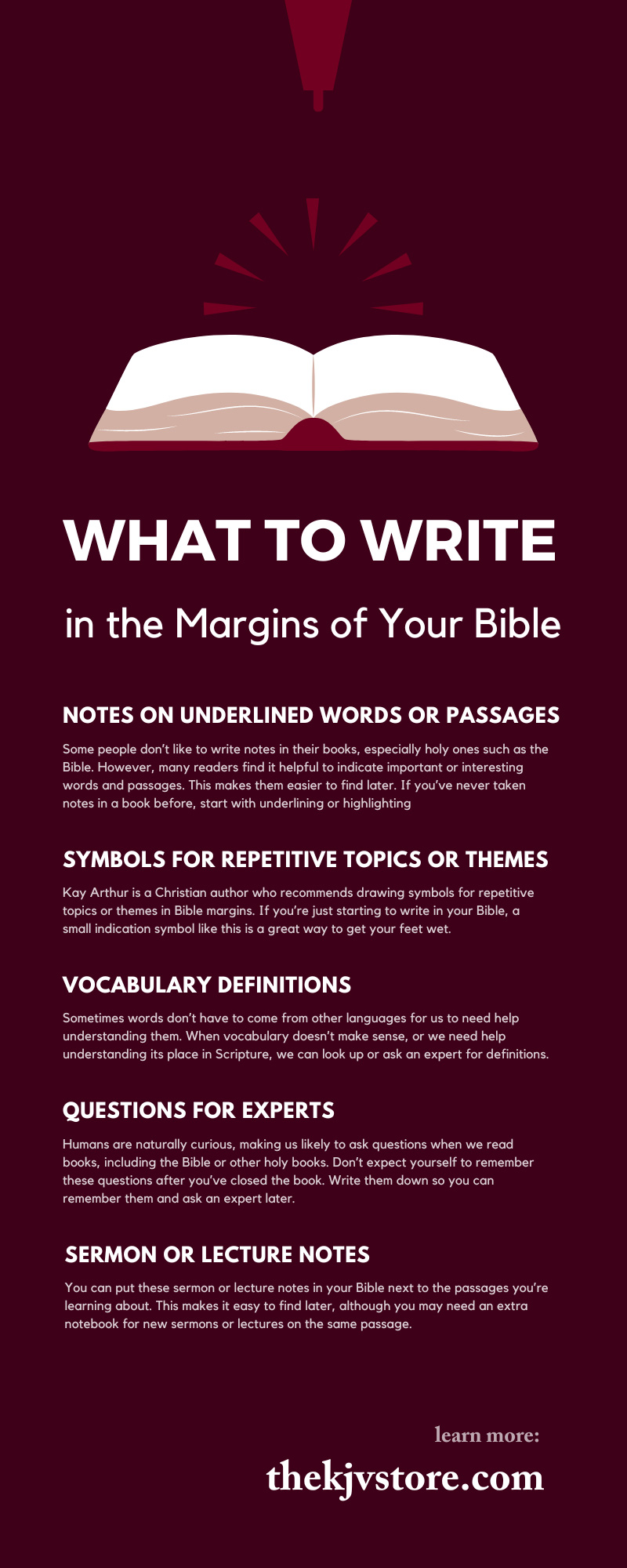What To Write in the Margins of Your Bible

Reading holy books for any religion can feel overwhelming. It’s easy to get lost in these important ancient tomes. While there are several ways to keep yourself on track, many Christians recommend writing in book margins. Writing in the margins can help keep you focused when you read and give you something to look back on when you return to specific passages. What should you write in the margins of your Bible or holy book, though? We explain the most helpful margin notetaking options for you below.
Notes on Underlined Words or Passages
Some people don’t like to write notes in their books, especially holy ones such as the Bible. However, many readers find it helpful to indicate important or interesting words and passages. This makes them easier to find later. If you’ve never taken notes in a book before, start with underlining or highlighting. Once you’re comfortable with these minor marks, you can work your way up to feeling comfortable with making full notes.
You can make any type of note you want next to underlined words or passages. Some people write the date of a sermon or lecture they heard about that passage because they have sermon or lecture notes elsewhere. Others write short notes summarizing the passage, such as writing “Gospel” next to John 3:16. Experiment with different note options to decide what makes the most sense when reading and returning to passages.
Symbols for Repetitive Topics or Themes
Kay Arthur is a Christian author who recommends drawing symbols for repetitive topics or themes in Bible margins. If you’re just starting to write in your Bible, a small indication symbol like this is a great way to get your feet wet. You can create your own symbol key in the front of your Bible or use symbols from one of Kay Arthur’s studies. Whatever symbol you use, making this small note will help you find passages with similar topics or themes. This is especially helpful for later reference, such as writing a paper about or planning a small group lesson on a particular theme.
Related Verse References
Another small note you can make in your Bible as you start to use the margins is to indicate related verse references. Scripture helps interpret Scripture, so Bible verses will reference each other. This is especially prominent in the New Testament as the authors reference the Old Testament. However, no one can memorize all these related verses. Writing related verse citations in the margins next to relevant Scripture can make finding the verses you need easier. People do this for religious classes, during sermons, while learning apologetic arguments, and more.
Hebrew or Greek References
Serious Scripture students often learn Hebrew or Greek while learning about the Bible. Whether you’re one of those students or you hear an expert explain these ancient languages, Hebrew and Greek can help us understand the Bible better. However, we can’t remember all those new words or expert references all the time. You can make a quick note in your Bible margin instead, writing down the Hebrew/Greek word or phrase that provides better context for a verse or passage.
Vocabulary Definitions
Sometimes words don’t have to come from other languages for us to need help understanding them. When vocabulary doesn’t make sense, or we need help understanding its place in Scripture, we can look up or ask an expert for definitions. Writing these definitions next to the challenging word allows us to learn and remember the meaning.
You can combine vocabulary definition margin notes with the symbol notetaking method described above. Create a symbol for a specific word you struggle with throughout Scripture. Define the word in the first place you see it. Then draw a symbol in the margins next to every instance of the word. This way, if you struggle to define the word in a later reading, you can look back and find the first symbol, which includes the definition.
Personal Experiences
Christians believe that we should apply the Bible to our lives because it is God’s word for believers. If you are a Bible-believing Christian, you should make personal application notes in your Bible. For example, after reading about Esther’s courage to stand up for her people, you may resolve to display more courage. Make a note in your Bible’s margin that one of your goals from this date forward is to show courage. When you read through this passage later, you can reflect on whether you’ve achieved this goal.
You can also make notes after experiencing something. For example, some people read the Bible for a long time before committing to live as a Christian. You can write the day you made that commitment next to the verse that inspired it, such as John 3:16. This allows you to reflect on your commitment and following experiences when you read over this verse in the future.
Questions for Experts
Humans are naturally curious, making us likely to ask questions when we read books, including the Bible or other holy books. Don’t expect yourself to remember these questions after you’ve closed the book. Write them down so you can remember them and ask an expert later. Leave space next to the question to write the answer you learn. Some experts may have different answers for the same question, so dedicate lots of margin space for these answers. Having the question and answer available next to the passage will help you understand the verses better during future readings.
Sermon or Lecture Notes
Some people can’t write notes when they’re reading on their own. When they hear someone else talk about a passage, though, they want to write important information down somewhere. You can put these sermon or lecture notes in your Bible next to the passages you’re learning about. This makes it easy to find later, although you may need an extra notebook for new sermons or lectures on the same passage.
Writing in the margins of your Bible is a great way to take your Bible study to the next level. If you need a large print, wide-margin KJV Bible for in-depth study, the KJV Store can help you find one. We have various large print wide-margin Bibles to pick from, such as leather and hardcover. If you only need large print or wide margins, we also have those options.

